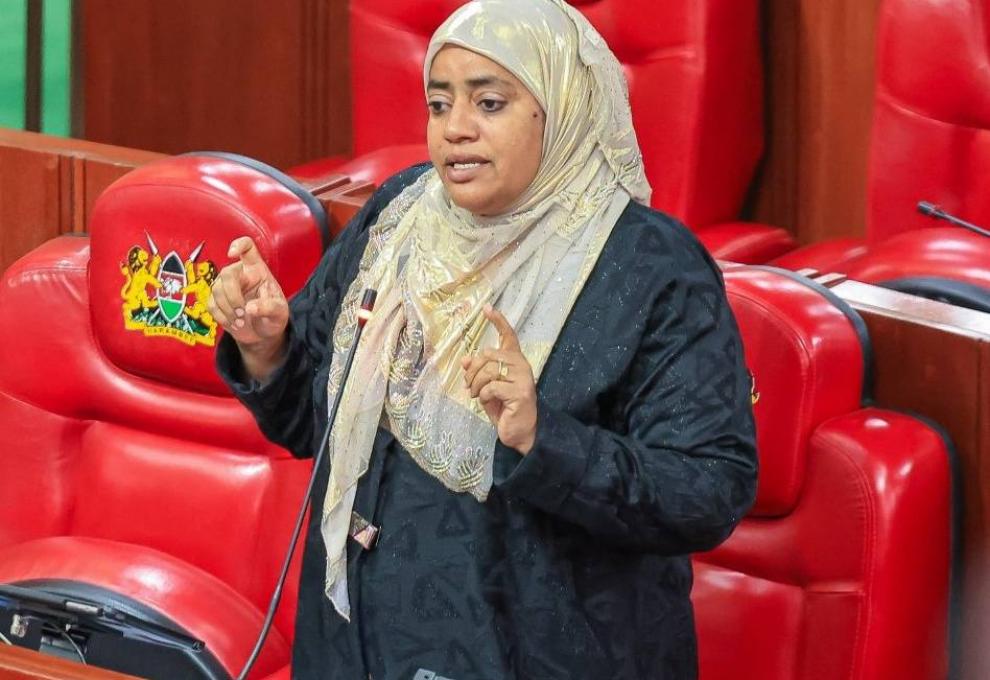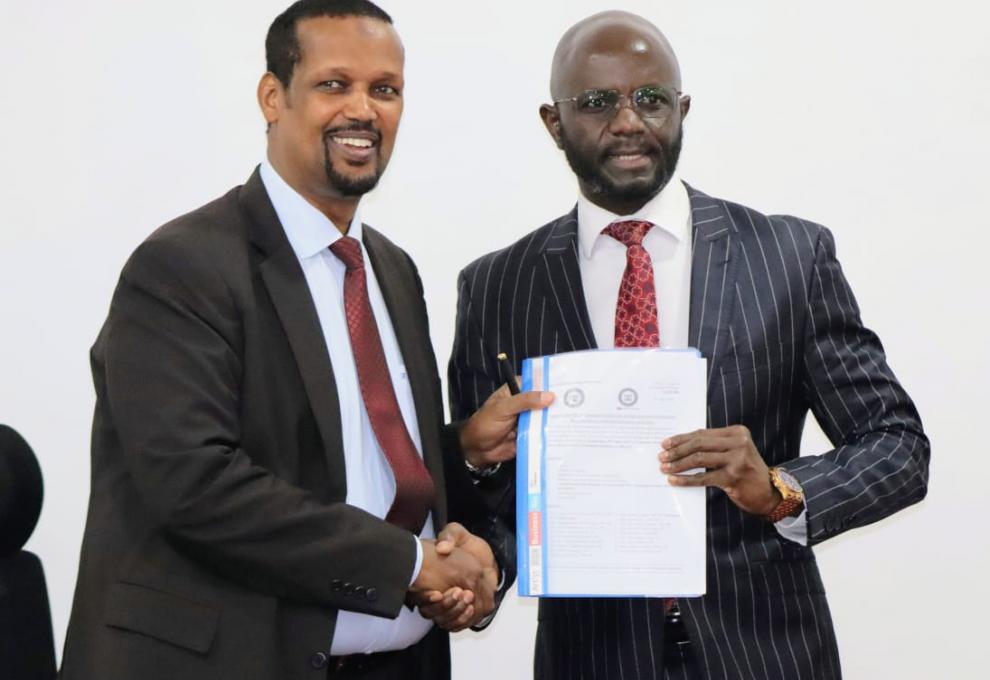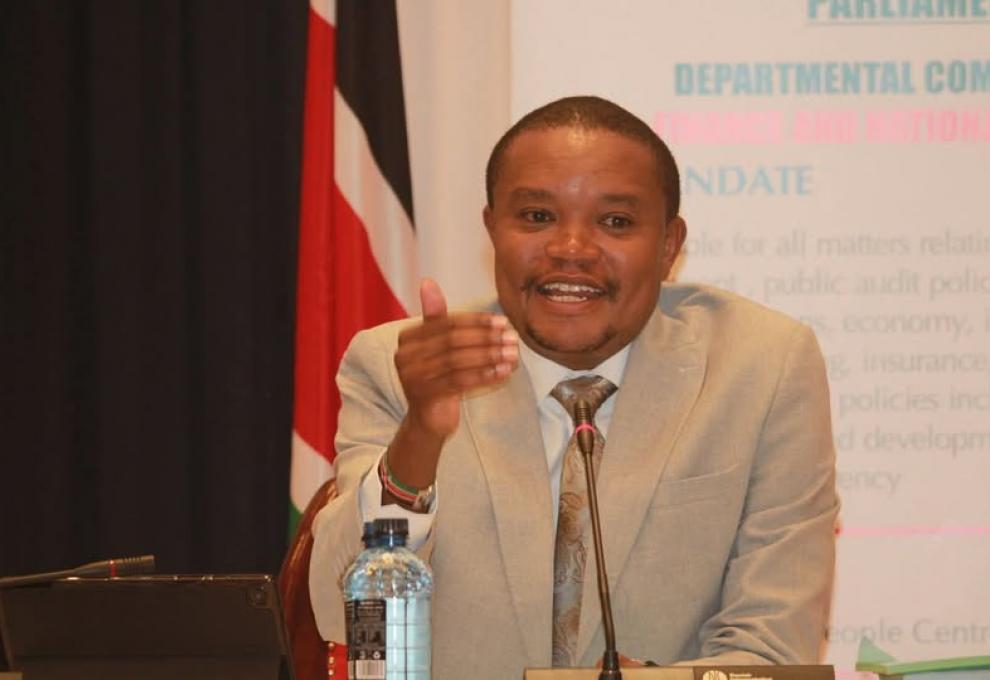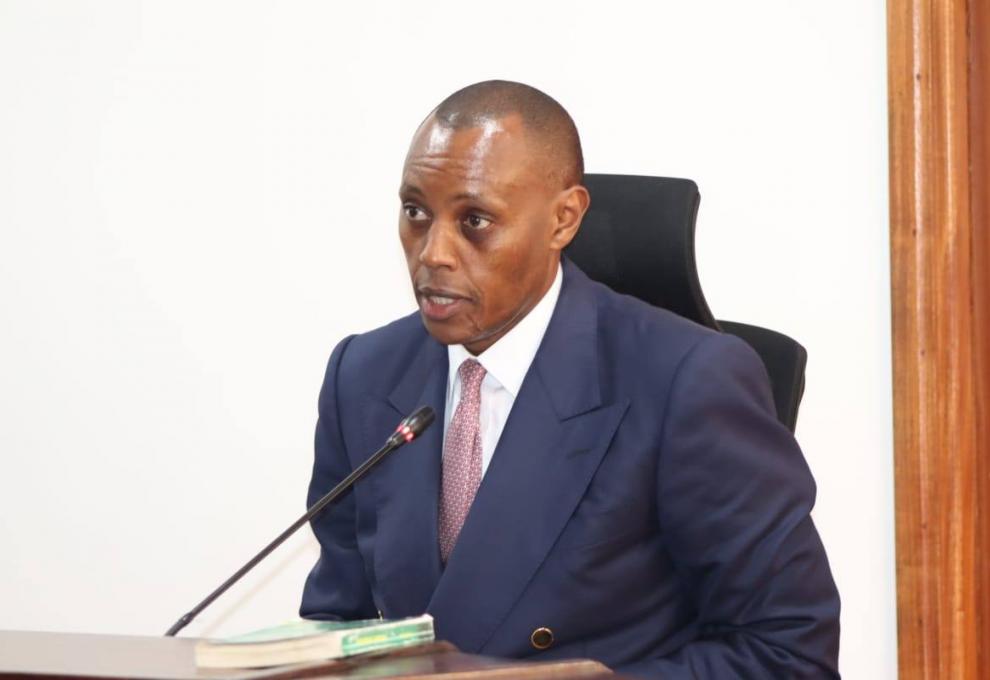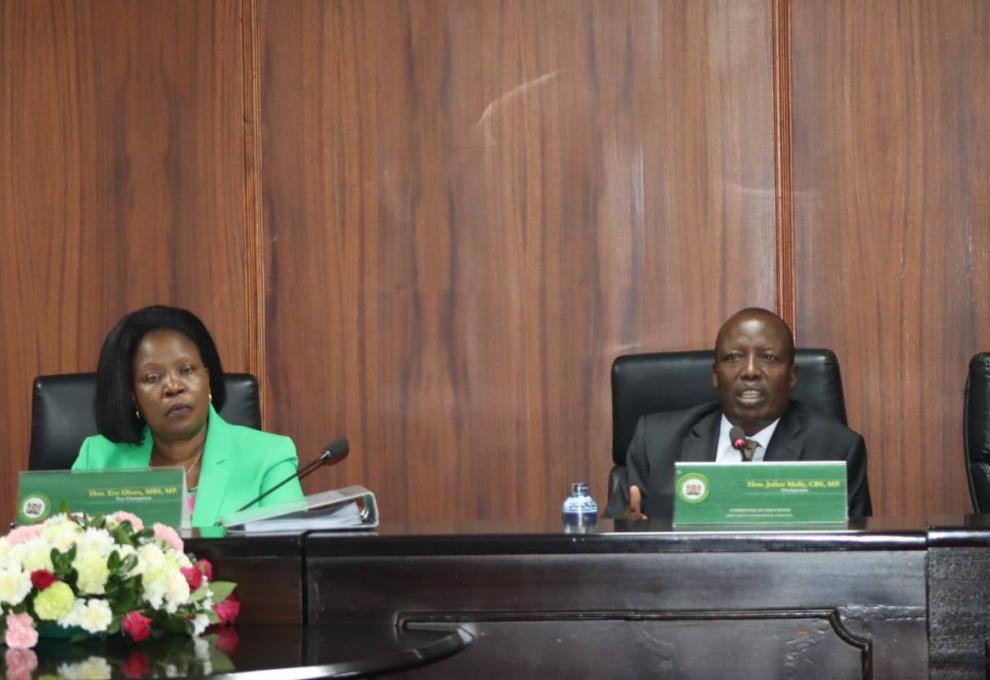Publications & Reports
COUNTY FACT SHEETS -2024 -APRIL-2025
Background Notes
The objective of the County Fact Sheets is to provide critical budgetary, financial, and economic information in a clear, concise, and accessible format to strengthen the oversight role of the Senate, inform policy formulation, and promote accountability in county governance.
This first edition draws on data from authoritative sources, including the Kenya National Bureau of Statistics (KNBS), Office of the Controller of Budget, Office of the Auditor-General, Commission on Revenue Allocation (CRA), and County Integrated Development Plans, among others.
Unpacking of the Budget Policy Statement for the Financial Year 2025/2026 and the Medium Term
The National Treasury projects that the economy will grow by 5.3 per cent in 2025 compared to 4.6 per cent projected in 2024. The agriculture sector is expected to be supported by favorable weather and implementation of BETA priority value chains; the services sector by investments in the ICT sector and government interventions to boost tourism and the industry sector by the anticipated reduction in production costs and initiatives to support value addition
Budget Options for FY 2025/2026 and the Medium Term
The 16th Edition of Budget Options seeks to address Kenya's fiscal challenges by proposing strategies to stimulate economic growth, create jobs, and improve service delivery. The strategies emphasize fiscal responsibility and efficiency in public expenditure and targeted investments in high-growth sectors to maximize economic potential and drive sustainable development.
The Fourth Basis for Revenue Sharing among County Governments
The Parliamentary Budget Office (PBO) presents a synopsis of the fourth basis of sharing revenue among counties. Kenya’s revenue-sharing framework, designed to allocate national funds to county governments, is undergoing revision to address ongoing challenges and ensure more equitable and inclusive development. Issues such as outdated data, inability to measure poverty gap changes, and insufficient funding have hindered the effective implementation of previous revenue-sharing bases. To address these, the Senate as per its constitutional mandate, in collaboration with the Commission on Revenue Allocation (CRA), is developing a fourth basis for revenue sharing for FY2025/26-FY2029/30. This new framework aims to resolve service delivery and economic disparity issues while adhering to the constitutional principle of equitable development as outlined in Article 203.
The macroeconomic context highlights steady global growth, with Kenya’s economy projected to grow at 5.4% between 2024 and 2029, driven by agriculture and services. However, the projected growth prospects is to be impacted by geopolitical tensions, climate change, fiscal consolidation measures, limited fiscal space and sticky real wages. Kenyan counties continue to rely heavily on the equitable share for financing, which constitutes a growing percentage of their budgets, increasing from 76.4% in FY2019/20 to 93.0% in FY2023/24. To resolve economic disparity and service delivery issues, the Fourth Basis framework introduces five key parameters with specific weights, i.e., Equal Share (22%), Population (42%), Geographical Size (9%), Poverty (14%), and Income Distance (13%). A stabilization factor is also integrated into the framework to protect counties from abrupt financial reductions. Emerging issues, such as unresolved constitutional disputes, concerns over data credibility, and a lack of scientific measurement for new factors like income distance index and stabilization factor, remain critical in shaping the future of the framework.
QUARTERLY ECONOMIC BULLETIN DECEMBER 2024
This Quarterly Economic Bulletin provides a brief of key recent economic and budget developments for 2024. It includes the macroeconomic and fiscal indicators as of the first quarter of FY 2024/25.
Budget Watch for FY 2024/25 and the Medium Term October 24 Edition 17
The 17th edition of the Budget Watch prepared by the Parliamentary Budget Office of Kenya aims to provide insights to the Legislature with regard to monitoring the budget implementation for the Financial Year 2024/2025.
Key highlights from the report include:
Global economic growth is projected to remain stable in 2024-2025, with regional variations. Kenya aims for moderate economic growth of 5.2% in 2024, driven by agriculture and services.
Kenya's fiscal outlook reflects the need to enhance revenue collection, rationalize expenditures, and manage rising debt, especially after the loss of the Finance Bill 2024. The fiscal deficit is projected to decline to 4.3% of GDP.
Ambitious revenue targets of Kshs.3.1 trillion are set for FY 2024/25, to be achieved through the full rollout of the Electronic Tax Invoice Management System, integration of KRA systems with counties and government entities, and a tax amnesty. The report highlights other key revenue administration gaps that need to be addressed.
Development expenditure allocation has reduced, with increasing dependency on development partners, who account for 43% of the development budget. Slow uptake of these funds remains a challenge.
Delays in approving the County Governments Additional Allocations Bill and a lack of agreements on loans and grants between national and county governments have affected the disbursement and utilization of additional allocations to counties.
The report emphasizes the need for balanced reforms to promote sustainable growth while addressing debt, inflation, and global economic risks as Kenya pursues its economic transformation agenda.
READ MORE...
Budget Watch for FY 2024/25 and the Medium Term October 24 Edition 17
2024/25 Budget Explainer
This document serves as a summary of the budget, highlighting key spending priorities in the National Government for the financial year 2024/25. This document is a crucial tool for enhancing transparency, accountability and public participation in the budget process. It serves as a bridge between the Government and the general public by making it easier to understand the allocation of resources and the Government's spending priorities and also enabling the public to grasp the key aspects of the budget.
Budget Options for FY 2024/2025 and the Medium Term
Introduction
A bleak global economic outlook has exposed the Kenyan economy to external shocks, from the surge in oil prices to the slowdown in debt markets and disruptions in global food chains due to escalating geopolitical tensions. The weight of financial constraints adds a layer of complexity to the risks faced by Kenya’s economy.
While revenue receipts continue to increase, their performance relative to the gross domestic product (GDP) has consistently remained below the target, averaging 16.6 percent. In the first half of FY 2023/24, the revenue was underperformed by Kshs. 187.6 billion. This trend does not augur well for the country’s debt position. Indeed, statistics as of June 2023 indicate that the debt-to-GDP ratio is estimated at 68.2 percent of GDP in 2023 in the present value terms. Additionally, the total debt service amounts to 58.80% of revenue. This leaves only 41.20% of tax revenue to propel government development programs. Moreover, a significant risk of debt distress persists, primarily arising from liquidity risks, while debt dynamics remain susceptible to fluctuations in exports, exchange rates, fiscal conditions, and natural disasters
In October 2023, the Parliament passed an amendment to the Public Finance Management (PFM) law, replacing the Kshs. A 10 trillion public debt numerical ceiling with a debt anchor set at 55 percent of GDP in present value terms. This goal should be achieved by 2029.
The 15th edition of the Budget Options focuses on the prevailing debt situation amidst other macroeconomic challenges, and proposes measures to actualize the debt anchor while ensuring sustainable and inclusive economic growth. As a priority for national development, it is imperative to decrease the debt service costs as a proportion of the budget. Simultaneously, Kenya should strive to enhance the value of money in its budgetary allocations. The proposed budget options outline measures from spending reviews aimed at bolstering efficiency, thus maximizing productivity for every shilling that is invested.
Budget Options for FY 2024/2025 and the Medium Term
Budget Watch for FY 2023/24 and the Medium Term
INTRODUCTION
The less than the desirable rate of economic growth of 4.8% in 2022 and rising debt load have reoriented the primary focus of the recent expenditure and fiscal reforms. This is aimed at: one, to refocus limited resources towards critical high productivity value chains and social sectors; two, to ensure a sustainable reduction of public borrowing by curbing the growth of the fiscal deficit; three, boosting domestic revenue collections to help bridge the resource gap; and four, to continue supporting development in the devolved units. The FY 2023/24 budget provides a strong anchor for renewed growth of the economy as highlighted by the Government’s Bottom-up Economic Transformation Agenda (BETA).
The Bottom-up Economic Transformation Agenda (BETA) has been designed to address the current challenges facing the country’s economy, stimulate economic recovery and bolster resilience. It places special emphasis on priorities that target reduction in the cost of living, creation of jobs, achievement of more equitable distribution of income, enhancement of social security, expansion of the tax base and increase of foreign exchange earnings.
The agenda is anchored on 5 pillars with the largest impact and linkages to the economy as well as on household welfare, and 12 enablers that aim at the creation of a conducive business environment for socio-economic transformation. The 5 pillars are: Agricultural Transformation; Micro, Small and Medium Enterprise (MSME) Economy; Healthcare; Housing and Settlement; and Digital Superhighway and Creative Industry. Likewise, the key enablers are: Blue Economy; Education and Training; Environment and Climate Change; Foreign Policy and Regional Integration; Governance; Infrastructure; Manufacturing; Service Economy; Women Agenda; Social Protection; Sports, Culture and Arts; and Youth Empowerment and Development Agenda.
To realize the aspirations of the BETA strategy spanning the value chains, delivery of enablers, the sustainable debt management, and delivery of social services, a number of interventions in the FY 2023/24 budget should be closely monitored. Some of the critical areas to continually monitor throughout the financial year include: the implementation of the fiscal consolidation strategy to ease debt vulnerabilities through boosting revenue collection measures while slowing down expenditure growth; full implementation of funded strategic priorities identified under BETA; maintaining macroeconomic stability to foster a conducive business environment; and good performance of various spending sectors including health, education, infrastructure, water and sanitation, agriculture, energy, trade and manufacturing.
This report will highlight the key interventions proposed in the FY 2023/24 budget that stakeholders should keep an eye on for successful implementation of the BETA strategy.
Budget Watch for FY 2023/24 and the Medium Term
UNPACKING OF THE ESTIMATES OF REVENUE AND EXPENDITURE FOR FINANCIAL YEAR 2023-2024 AND THE MEDIUM TERM
The 2023/24 budget is the first under the current government administration and is expected to set the pace of economic performance for the next five financial years. It has been prepared against a background of significant global economic uncertainty with the ongoing Russia-Ukraine conflict, agitated financial markets, and tightening monetary policy which has led to significant slowdown in economic growth.
On the domestic front, the economy is experiencing significant macroeconomic challenges. Lingering effects of drought continue to pose a risk to increased agricultural production, even as the 2023 long rains are expected to enhance food security in the coming months. The business environment has deteriorated, denoted by a decline in the PMI index in the first quarter of 2023 to 47.2 percent[1]; attributed to a cutback in consumer spending due to high inflation. The Kenya shilling has declined significantly against the dollar resulting to a reduction of the forex reserves below the statutory four months of import cover and increasing the risk of debt distress. Indeed, the country is facing an increasingly vulnerable debt position underpinned by undersubscription of domestic bond issuance, constrained access to international capital markets and a downgraded credit rating by S&P from stable to negative which has increased the country’s risk profile.
The 2023-24 budget therefore faces the unenviable task of rebalancing the economy by implementing corrective policies aimed at addressing debt vulnerabilities while at the same time using available fiscal space to implement structural policies that will boost investment and economic productivity.
Updated Monday 13th February, 2023
BUDGET OPTIONS FOR FY 2023/2024 AND THE MEDIUM TERM
FISCAL CONSOLIDATION IN THE MIDST OF A GLOBAL RECESSION, WHAT IS THE MAGIC?
That the country is facing significant debt vulnerabilities is no longer a matter of conjecture. IMF Debt Sustainability Analysis for 2022 established that Kenya is in breach of four of the six indicative thresholds for debt burden indicators, namely: the PV of public debt to GDP ratio; the PV of public debt to revenue and grants ratio; the PV of PPG External debt to exports ratio; and the PPG debt service to exports ratio. This essentially means that the country is at a significantly higher risk of debt distress.
Available statistics as at June 2022 indicate that total debt service as a percentage of revenue was estimated at 47.9%; implying that for every Ksh. 100 collected as tax revenue, Ksh. 47.9 is used to service debt. This Leaves only 52.1% of the tax revenue to finance an ambitious government development programme in an economy experiencing a high budget deficit that requires further borrowing in a recessionary global environment. Furthermore, the breach of the external debt to exports ratio is especially worrying, because it implies that the country is not generating enough forex from exports to comfortably service its external debt. As a result, there are concerns that we are living beyond our means.
In order to address these prevailing challenges, the new administration has expressed commitment to undertake fiscal consolidation that will enable it to achieve a deficit financing target of 5.8 percent of GDP in FY 2022/2023 and 3 percent by FY 2026/2027. This will be achieved primarily through rationalization of expenditure. The Bottom-Up Economic Transformation Plan outlines a cautious revenue projection path along with limited growth in expenditures and budget neutrality as the key guiding principles for policy implementation. For new programmes that need to be financed, the plan is to release resources from other programmes or projects that are either completed or closed. Furthermore, external borrowing will be limited and will mostly target concessional financing. Despite the perceived gains of fiscal consolidation on debt accumulation, conventional wisdom indicates that this is likely to have a contractionary effect on economic activity, at least in the short run. Economic theory heralds that in order to spur economic production in times such as what Kenya is currently facing, the economy requires injections into the financial system. The strategy adopted by the new administration of fiscal consolidation is in contrast.
Budget Options for FY 2023/2024 and the Medium Term
Updated Friday 11th November, 2022
ASSESSMENT OF THE COST IMPLICATIONS OF THE BOTTOM-UP ECONOMIC TRANSFORMATION PLAN 2022-2027
The Bottom-Up Economic Transformation Plan 2022-2027 is the manifesto of the Kenya Kwanza administration that will be implemented over the next five years. The plan has been conceptualized at a time when the economy is facing major headwinds from domestic and global fronts which has resulted in a cost-of-living crisis. The plan is cognizant of the prevailing domestic challenges including constrained fiscal space and structural imbalances which have weakened the economy as well as external factors such as rising global inflation and interest rates, long term impact of the Covid-19 pandemic and the Russia – Ukraine conflict among other geopolitical dynamics.
Does the 2022/2023 budget set a pace for the new administration?
The 2022/2023 budget is being implemented at a time when the economy is facing significant internal and external challenges. Externally, the global economic outlook remains uncertain due to a number of prevailing challenges notably high inflation and negative spill overs from the Russia-Ukraine war. High inflation particularly in the United States has led to interest rate hikes leading to the weakening of the Kenya shilling and other global currencies against the dollar. On the other hand, the Ukraine-Russia conflict has resulted in supply chain disruptions and a general increase in global commodity prices especially that of fuel, liquefied petroleum gas, food grains and fertilizer. It is noted that Kenya relies on Russia for import of wheat, fertilizers, iron and steel, and paper. On its part, Ukraine is a major exporter of grains in the world market and over the years, Kenya has imported cereals, oilseeds and seeds, animal/vegetable fats and oils from Ukraine. This business environment has been complicated by the fact that COVID-19 global pandemic had already created business challenges in the manufacturing and hospitality industries that were just starting to recover before the Ukraine-Russia conflict.
Budget Watch for 2022/2023 and the Medium Term
Unpacking of the 2022-23 budget 9.5.2022
The 2022/2023 budget will be implemented during a transition period hence the pressure of having to complete the on-going programs while creating fiscal space for implementation of the new policy discourse. The budget not only coincides with the first year of the new government after the upcoming general elections, but also concludes implementation of the third Medium Term Plan and ushers in the fourth Medium Term Plan. The challenge of the 2022/2023 budget, therefore, is to midwife the two processes smoothly. There is pressure to complete ongoing projects while at the same time ensuring that the budget provides a sound platform of operation for the next five years.
Unpacking of the 2022-23 budget 9.5.2022
Final Quarterly brief - the Russian-Ukraine conflict 2022
The genesis of the Russia-Ukraine conflict is a geopolitical standoff between the North Atlantic Treaty Organization (NATO) and the Russian Federation over Ukraine’s intention to join NATO.Russia is classified as one of the world’s largest producers and exporters of oil and gas, metals and minerals as well as chemical fertilizers. It is also a significant player in cereals and grains in the global economy. Equally, Ukraine is a major exporter of grains in the world market. Over the years, Kenya has imported goods such as cereals, oilseeds and seeds, animal/ vegetable fats and oils from Ukraine.</p> <p>Kenya is the fourth largest trading partner with the Russian Federation in Sub-Saharan Africa after South Africa, Senegal, and Nigeria. The total volume of trade between Kenya and Eastern Europe is approximated at Kshs. 59,591 million with a trade deficit of Kshs 33,407 million in favour of the Russian Federation as of 2020.
Final Quarterly brief - the Russian-Ukraine conflict 2022
Unpacking of 2022 of Budget Policy Statement
Introduction:
The policy thrust of the 2022 Budget Policy Statement is captured in two broad categories: the Economic Stimulus Programme and the Big Four Agenda. The primary objective is to accelerate economic recovery through some select priority economic policies and structural reforms to be implemented in the 2022/23 – 2024/25 MTEF period. The theme of the 2022 BPS is, “accelerating economic recovery for improved livelihood.”
Unpacking of 2022 of Budget Policy Statement
Introduction
Budget Options for 2022/2023 and the Medium Term
The medium-term outlook (2022/23 – 2023/24) remains uncertain and subdued for several reasons. Firstly, the conduct of the electoral process is a key determining factor: high political tensions are likely to seriously dampen economic activity whereas a more contained electoral process could lead to moderate growth. Secondly, the prevailing drought conditions could spill over into 2022 with agricultural activity notably farming and transportation of produce likely to be further subdued due to fear of violence or actual eruption of violence. Thirdly, the lingering effects of the COVID pandemic remain a threat and there is a risk of deadly resurgence as the campaign activities which typically flout all social distancing directives increase significantly in a population with low vaccination rates. The Budget Options for 2022/2023 recognizes these challenges to the economy and proposes some measures to mitigate such risks.
Budget Options for 2022/2023 and the Medium Term
Introduction
Budget Watch for 2021/2022 and the Medium Term
The 2021/2022 budget is an economic recovery budget that is expected to spur economic activities in the country thereby enhancing growth prospects. The budget has been prepared at a time when the global economy is experiencing a rebound in growth largely due to extensive vaccination efforts in a few large economies that has led to the lifting of most covid-19 containment restrictions. Domestically, the country is showing some signs of economic recovery even as it continues to deal with the covid-19 pandemic and its adverse effects. Notably, the Service sector which was the most adversely affected by the pandemic has shown significant improvement and is likely to post a much better performance this year compared to 2020. To illustrate, the education sub-sector which registered a significant decline in 2020 has fully resumed its activities. Significant recovery is also observed in the transportation sub-sector as well as wholesale and retail. On the other hand, the recovery in the accommodation and restaurant sub-sector has been slower due to slowdown in tourism and continuation of social distancing directives. It is largely expected that increasing the vaccination coverage coupled with implementation of the strategic priorities of the government under “the Big Four agenda” and the “Post covid-19 Economic Recovery Strategy (ERS)” will bring about economic recovery. The theme of the 2021/2022 budget is “Building back better: strategy for resilient and sustainable economic recovery and inclusive growth.”
Budget Watch for 2021/2022 and the Medium Term
Background information
The 2021/2022 budget has been prepared against the background of a precarious economic situation, as the country continues to address the challenges associated with the covid-19 pandemic and its adverse effects, one year on. Between March and April 2021, because of a lethal third wave of the pandemic, the country had to once more contend with strict covid containment measures reminiscent of the first wave in March 2020. It is worth noting that the country entered this third wave in a more precarious position than the first wave due to higher unemployment and poverty levels. The distribution of vaccines is expected to significantly improve the situation by bringing the pandemic under control. However, in Kenya and indeed most countries in sub-saharan Africa, the distribution and uptake of the vaccines has been quite slow. This will have an impact on the duration of the pandemic and consequently, its effects on economic growth.
Read More..
Unpacking the Estimates of Revenue and Expenditure for 2021/2022 and the medium term
Budget Options for 2021/2022 and the Medium Term
The Kenyan economy is currently facing significant challenges with the COVID-19 pandemic worsening an already dire situation. Indeed, the economy was already showing signs of distress even before the COVID pandemic.
The Budget Options for 2021/2022 recognizes these challenges to the economy and proposes some measures to reduce the expenditure pressures and accord the country some fiscal space.
Read More..
Budget Watch For 2020/2021 And The Medium Term
The 2020/2021 budget is a crisis budget that must balance between mitigating the socio-economic impact of a health pandemic while still providing adequately for existing administrative and economic needs. This budget is being implemented at a time when the economy is navigating uncharted waters on account of the COVID-19 pandemic....
Read More
Half Year Economic & Fiscal Update, August 2020
This brief provides a summary of key recent economic and budget developments and is intended to keep stakeholders especially the legislators updated on the latest trends in the economy.
Read More..
Half Year Economic & Fiscal Update, August 2020
ANALYSIS OF THE FINANCE BILL, 2020
Introduction
The Finance Bill is prepared in accordance with Sections 40 and 41 of the public Finance Management Act, 2012. Principally, the Bill is intended to introduce amendments to the existing tax laws in a bid to raise additional revenue to finance the budget in a fiscal year and subsequent ones. The Finance Bill also proposes to grant various tax incentives targeted to spur economic growth so as to yield increased revenue in future. Finally, the Bill introduces miscellaneous amendments to various financial sector statutes to enhance enforcement and streamline administrative measures.
This Bill proposes to amend some sections of the Income Tax Act, Value Added Tax Act, Excise Duty Act, Miscellaneous Fees and Levies Act, Tax Appeals Tribunal Act and the Tax Procedures Act. Also, there are proposed amendments to eight (8) financial sector statutes to address varied aspects in relation to the policies underpinning the budget in medium term. The statutes are: the Public Roads Tolls Act, the Capital Markets Act, the Insurance Act, The Standards Act, the Retirement Benefits Act, the Kenya Revenue Authority Act, the Roads Maintenance Levy Act and the Insolvency Act.
Read More..
Analysis of the Finance Bill 2020
The Unpacking of the Estimates of Revenue and Expenditure for 2020/21 and the Medium term
The Unpacking of the Estimates of Revenue and Expenditure for 2020/21 and the medium term provides a critical evaluation of the extent to which the Budget for FY 2020/21 will respond to the COVID-19 pandemic and also its adherence to the tenets outlined in law as well as international best practice.
Read More...
The Estimates of Revenue and Expenditure for 2020/21 and the Medium term
Unpacking of the Supplementary Estimates No.II for Financial Year 2019-20
The second supplementary estimates for financial year 2019/2020 were submitted to the National Assembly on 14th April 2020. This is pursuant to Article 223 of the Constitution and section 44 of the Public Finance Management Act 2012, which provide for.......
Read More...
Unpacking of the SE-No. II for 2019-2020
The COVID 19 global pandemic: Impact to the economy and policy options
The outbreak of a novel coronavirus disease (COVID 19) in China has quickly morphed into a global pandemic that is threatening the world economy. In December 2019, China alerted the World Health Organization (WHO) to a rising number of cases of unusual pneumonia in Wuhan, a port city of 11 million people in the central Hubei Province.
READ More...
The COVID 19 global pandemic: Impact to the economy and policy options-Special Bulletin
Unpacking Of the Budget Policy Statement & Medium-Term Debt Management Strategy 2020
The 2020 budget policy statement provides for fiscal policies that are meant to sustain Kenya’s economic growth under a sluggish global growth. It sets the tone of the various policies that will need budgeting over the medium term so as to harness the national agenda i.e. “the Big 4 Agenda” for job creation and economic prosperity.
Budget Policy Statement & Medium-Term Debt Management Strategy 2020
Unpacking of the Supplementary Budget I for FY 2019/20
The Unpacking of the Supplementary Budget I for FY 2019/20 provides a critical evaluation of the extent to which it deviates from the Approved Budget for FY 2019/20 and also its adherence to the tenets outlined in law as well as international best practice.
The Supplementary Budget I for FY 2019/20
The Budget Watch 2019/2020 12th Edition.
The Budget Watch disseminates findings of the Parliamentary Budget Office on key issues regarding the budget estimates in a particular financial year. The findings of the 12th edition of the Budget Watch have been disseminated in the process of scrutiny of the budget for the financial year 2019/2020 by the Legislature.
The Budget Watch 2019/2020 12th Edition
Quarterly Brief 24 April 2019
Anatomy of a Food Crisis, "Can Kenya rise above the perennial hunger?"
Drought and famine in Kenya is an increasingly common phenomenon. Unless leaders rise to the occasion, food shortage will continue to persist.
The Budget Options for 2019/20
The Budget Options for 2019/20 explores the dynamics of moving the economy from the 5-6% economic growth rate where the economy has stagnated over the past five years to a higher growth trajectory that will reduce poverty and enhance the living standards of Kenyans. The challenge lies in unlocking a higher productive capacity.
View/Download
The Budget Options for 2019/20
Background Information
The PBO was established in the year 2007 as a unit under the Directorate of Information and Research services following a resolution of Parliament. The office further got a legal backing with the enactment of the Fiscal Management Act 2009 (FMA), which established the PBO as an office in the Parliamentary Service Commission. The office was subsequently elevated to a directorate in 2010.
This Analysis of the Finance Bill, 2018
The Finance Bill, 2018 contains various changes to the Income Tax Act, VAT Act, Excise Duty Act, Miscellaneous Fees and Levies Act, Tax Tribunal Act and Tax Procedures Act. Changes on tax rates or tax measures are estimated to yield at least Ksh. 30 billion. The Bill also introduces various........ read more, below attached pdf
2018/19 Budget Watch
The Budget Watch disseminates findings by the Parliamentary Budget Office on key issues regarding the budget estimates in a particular financial year. The findings of the 11th edition of the Budget Watch have been disseminated in the process of scrutiny of the budget for the financial year 2018/2019 by the Legislature.
The Half Year Economic & Fiscal Update, August 2018
This brief is a supplement to the monthly bulletin which details key economic and budget developments in a given month. The 2018 half year update gives a more detailed analysis of economic performance in the course of the financial year. It is intended to keep stakeholders especially the legislators updated on the latest trends in the economy.










